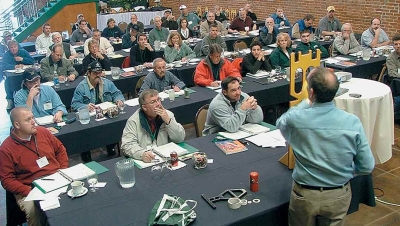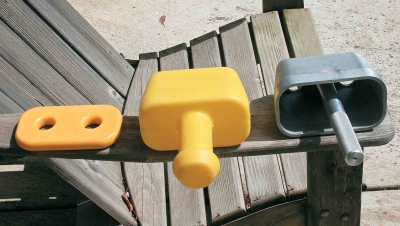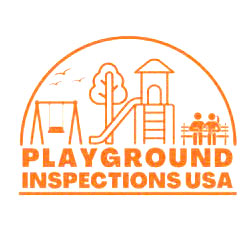Is there Value in Professional Certification for Playground Inspectors?
In the late 1990s, I met a Certified Playground Safety Inspector (CPSI) candidate by the name of Dwight Curtis. This young man was very interested in conducting his Ph.D. research on the parks side of our profession. He said he had an interest in the area of playground safety. We chatted about many things related to playground management. My suggestions focus on the new emerging playground safety standards and whether or not these standards and our CPSI training were having any measurable impact on public playground safety and injury reduction. I believed in my gut the CPSI Program and its national certification designation, while still very new at that time, was having a significant positive impact resulting in a measurable reduction in playground injuries and the long term this certification program would result in cost savings from less litigation.
These theories were nothing more than my opinions based on personal observations over the previous 10 years. I attributed these perceived improvements to the industry-wide need for this training demonstrated by the rapidly increasing number of CPSI Courses and participants during this period of time. I also observed a steady increase in the playground manager’s awareness of the most common playground hazards. This coupled with the major efforts to address these common playground hazards by the playground equipment designers and manufacturers were all positive steps in improving the basic safety of the playground environment. Unfortunately, there was no research to prove my observations right or wrong.
There were some obvious signs such as the obvious growing numbers of CPSI candidates and courses around the country and a dramatic industry-wide increase in sales of both playground equipment and protective surfacing. My experience and opinions were anecdotal evidence at best therefore I suggested Dwight consider a research project that would prove one way or the other that there was true measurable value in being a CPSI. I believed all agencies who hired a trained and experienced CPSI would also benefit in different measurable ways.
I was of the opinion that when research could demonstrate the positive impact of a CPSI that NRPA would be able to convince all policymakers and agency managers of the need for, and value of, having a CPSI on staff in every park and recreation agency, school district, and childcare facility in America. I also believed the benefits of having CPSIs on staff should be able to be measured within every playground equipment and surface system designer/manufacturer, distributor, installer, or private contractor involved in creating a public playground existence.
It took approximately 15 years to get some research to support the value of a CPSI. Somebody finally rolled up their sleeves and set out to demonstrate the value of a CPSI and in so doing provide us with the data necessary to support the need and importance of a CPSI on every agency in America that operates one or one thousand public playgrounds. I am proud to introduce the results of Dwight Curtis’s research. The following information comes from Dr. Dwight Curtis’s study. I apologize for taking liberties in bringing the basic findings and processes used to come to the conclusion that having a CPSI on staff has a positive effect on an agency’s perception of the value of CPSI designation and the work a CPSI does in making playgrounds safer and reducing injuries to their playground users.
A Dissertation Presented in Partial Fulfillment of the Requirements for the Degree of Doctor of Philosophy with a Major in Education in the College of Graduate Studies University of Idaho
by Dwight L. Curtis July 24, 2012: Major Professor: Damon Burton, PhD
"Despite the implementation of certified playground safety inspector programs to reduce injuries, the U S. still faces high injury rates on public playgrounds. The objective of this study was to examine playground certification effectiveness in reducing reported injuries on public playgrounds in California.
A correlational framework was utilized to examine relationships among playground injuries in three different size municipalities and certification in the state of California during a 10-year period.
Additionally, the influence of model components such as playground safety inspectors’ and their supervisors’ beliefs and attitudes about certification status, experience level, and available resources on injury outcomes were also investigated.
Survey data was collected primarily online from 247 inspectors, their supervisors, and organizational risk management specialists, with a response rate of 60.3%.
The number of playground safety inspectors increased 48.7% over the past decade. Two-way repeated measures ANOVA variance examined differences in injury rates for three assessment years (2000, 2005 and 2010) in three different city sizes and for two types of certification status, resulting in significant differences in injuries over time, certification status by time, city size by time, and certification status by city size by time.
ANOVA results found greater declining injury rates for cities with certified inspectors than those without, but only the data for 2010 was significant. Exploratory factor analyses identified five inspector and four supervisor perception dimensions, and these dimensions were moderately correlated with each other and with injury rates.
Interestingly, supervisor perceptions were more strongly related to injury rates than those of inspectors. Cluster analysis results created injury and inspector profile groups, and MANOVA was used to examine differences between profiles. The high-decreasing profile group was significantly more related to more positive inspector and supervisor perceptions than was the low-increasing profile.
The high-positive inspector perception profile was also significantly associated with lower injury rates than the other four profiles.
While national playground injury rates are increasing over the past decade, California’s have decreased. Thus, California’s playground safety regulation provided a good platform to examine certification effectiveness. Overall, results clearly support positive relationships between certification, inspector and supervisor perceptions, and the working model and injury reductions on California playgrounds.”
Studies on the Value of Professional Certification
Curtis found studies that suggested there were increasing numbers of employers who were turning to certifications as a means of ensuring potential employees actually do have the requisite skills for an occupational specialty. Just as a degree from an accredited university provides solid evidence of advanced learning, professional certification is viewed by an employer as credible evidence of skill and knowledge within a particular profession.
The State of California took this to the extreme by requiring all public playgrounds to be initially inspected and certified by a Certified Playground Safety Inspector (CPSI) from the National Recreation and Park Association’s CPSI Course and Exam. This was to occur before the playground was opened to the public (California Playground Safety Regulations, 1999). Interestingly, California is still the only state with this requirement.
Curtis’s research also sought to determine if certification or non-certification impacted quality-cost improvements and waste-cost reductions. The statistical results found no significant differences between those companies with certified employees and those without. If this finding was universal, then the conclusions could be significant for all professions. In explaining the study results, it was concluded that the success of the companies would require more than just people with certifications.
Interestingly, Curtis found that certification was not always valued. He found many older established employers in the project management profession had little knowledge of the professional project management certification. While the employer might notice the certification on a resume, they weren’t necessarily interested in applicants with the professional certification credential. This finding was worth mentioning because this bias could just as easily pertain to those hiring people to maintain and manage playground safety.
Another basis for lessened appeal for professional certification is certification fraud or cheating to provide or obtain a professional credential. Employers can no longer assume that potential employee certifications were genuine, casting further doubt on the value of certification. When employers no longer value certification as a hiring, promotion, or compensation criterion, professionals in any field start to question its value as well.
This study gave some credence to the point there was no empirical statistically significant distinction between the capabilities of certified network professionals and non-certified network professionals. This conclusion was counter to the hypotheses of this study that predicts statistically significant differences between the capabilities of certified and non-certified playground safety inspectors which may impact injury rates.
By far, the highest concentration of research found on the effects of certification was in the field of education and teacher certification. Common sense suggests that the quality of teachers impacted student achievement and that a certified teacher would promote greater impact than a noncertified one. However, a review of the literature suggested that accurately measuring teacher quality was challenging and not as clear-cut as might be assumed. A study that examined the underlying assumption that teachers were important predictors of student achievement concluded that teacher experience, education, and certification were not strongly correlated with student achievement. This study did find some evidence that supported teacher experience as positively associated with students’ mathematics and reading outcomes. The author of the study also cautioned that the lack of significant effects should not be interpreted as evidence that teachers produced no impact on student achievement.
One study found large differences in quality among teachers within schools. A standard deviation increase in teacher quality raised test scores by approximately 0.1 standard deviations in reading and math while teacher experience significantly raised student test scores, particularly in reading, with a 0.17 standard deviation difference between beginning teachers and those with 10 or more years of teaching experience. Unfortunately, the empirical research did not address teacher certification or education.
Curtis observed a comment in the report that policies rewarding teachers based on credentials may be less effective than policies rewarding teachers based on performance. His observation could be related to employers possibly rewarding playground safety inspectors (e.g., pay raises, promotions, or special recognition) because they achieved certification rather than actually being able to show a reduction in children’s playground injuries as a result of their certification.
In a (2007) study researchers compared the effectiveness of certified and noncertified teachers (i.e., National Board for Professional Teaching Standards (NBPTS) certification) based on the following questions that may be relevant to playground safety inspector certification.
- Is certification a good indicator of teacher quality in the teacher labor market as a whole?
- Did certification provide any information about teacher effectiveness that goes beyond what was already provided by licensure exams (i.e., Are licensure tests just as good as certification at identifying effective teachers)?
- Did these certification standards identify the most effective teacher candidates?
- Finally, is the certification process itself a facilitator for building human capital?
These researchers found that the NBPTS assessment process did distinguish between more- and less-effective teachers. Teachers who were certified tended to be more effective than unsuccessful applicants to the program. While consistently finding that certified teachers were more effective, there were mixed findings about their effectiveness post-certification. The study found no evidence that certification acted as a catalyst for effective teaching, but their results did support the notion of building human capital. National board-certified teachers (NBCTs) appear to be no more effective, and in some cases, less effective after certification than before certification. The main conclusion from this research was that the National Board successfully identifies effective teachers, findings that were similarly supported by additional research in 2009. By comparison, these four questions seemed relevant in examining CPSIs.
Similar research was conducted over a 10-year period. In contrast to earlier results, this study concluded that measurable credentials account for a substantial percentage of the total effect of teacher quality on student achievement. A variety of teacher credentials were included in the analysis, so it was not as specific to the NBPTS certification study. However, the longitudinal approach utilized a broader meaning of the credential and made sense because it bypassed the notion of a singular fix-all certification and could possibly apply to certifications across all professions, including the playground safety inspector certifications. The meaning of credential included the training for the certification itself, the various experience factors of the teacher, the resources needed to do the job, and the policies in place. This broader meaning, however, was also confusing as it diluted the distinctness of the certification itself, but these findings were consistent with previous research.
Kutska Comment: These findings support the notion that credentialing CPSIs on their knowledge of public playground safety standards and guidelines through initial testing coupled with the requirement to re-testing every three years to the current body of knowledge or standard of care has merit. There is a need to stay up-to-date with current safety standards and guidelines in order to remain relevant in meeting the CPSI’s employer need for continuing education on the current standard of care objective thereby improving on the ultimate goal of reducing playground injuries. This has been the National Playground Safety Institute’s primary objective from the very beginning of the NRPA CPSI Certification program. We understand the body of knowledge on public playground management is not static therefore re-testing every three years has been a prerequisite for holding the credential as a CPSI in good standing in lieu of continuing education units.
Studies that Support the Value of Certified Playground Safety Inspectors
No studies were found that examined the effectiveness of the playground safety inspector certification in reducing reported injuries sustained on public playgrounds. Also not found, were previous studies that investigated the primary elements of the hypothesized model on the relationships between;
- the beliefs and attitudes of playground safety inspectors and perceived job effectiveness
- their supervisors’ beliefs and attitudes toward the CPSIs’ job effectiveness,
- the effect on the actual number of reported injuries.
Therefore, the purpose of this exploratory research was to conduct a study to examine the effectiveness of the playground safety inspector certification on the reduction of reported injuries sustained on public playgrounds in the state of California. In order to accomplish this analysis it would be necessary to study three hypotheses that emerged from Curtis’s study and the elements of the CPSI Certification Effectiveness (CPSI-CE).
- Injuries decreased when a CPSI is hired.
- CPSI beliefs in the playground inspection system influenced injury rates.
- Supervisor's value placed on their playground safety inspector program affected injury rates.
The first purpose of this study was the fact that while there was considerable research on playground safety, none was found specific to playground safety inspector certification. However, reports published by the NRPA and associated professional periodicals, as well as discussions on playground certification issues by parks and recreation professionals, overwhelmingly point to three powerful prevailing elements guiding certification effectiveness, including;
- current certification
- experience
- resources
(Cegielski et al., 2003; Hudson et al., 2004; Iverson & Payne, 2008/2009; Jepsen & Rivken, 2009; Ginsburg, 2011; Kutska, 2008a, 2008b; 2008/2009, 2009; Miller & Svara, 2009; Mulvaney, 2010; National Playground Safety Institute, 2010; National Program for Playground Safety, 2011; National Recreation and Park Association, 2008, 2011; Peterson, 2002; Stoddard, 2008, 2009).
The second purpose of this study was to develop a model to identify the three primary elements of playground safety inspector certification and examine how each influences reducing injuries on public playgrounds. The Curtis Playground Safety Inspector Certification Effectiveness Working Model (CPSI-CEWM) was developed to fulfill this need and focuses on the impact these elements had on creating an effective playground safety inspector. Ultimately, Curtis was looking to substantiate any measurable positive impact and value CPSI certification had on improving the quality and safety of their agency's playgrounds while reducing the number and severity of injuries.
Curtis's Tool for Measuring Certified Playground Safety Inspector Effectiveness
Curtis’s research paper spans more than a decade of data comparison coupled with personal survey results of agencies within California. The Certified Playground Safety Inspector, the inspector’s supervisor, and the agency's risk manager were surveyed and those results were compared with injury data supplied by the agency's risk manager and analyzed. We will look at what Curtis identifies as the three powerful prevailing elements guiding certification effectiveness. They include the relationship between; current certification, experience, and resources.
The following studies were used as a basis for supporting the conclusions of Dwight Curtis’s research.
National Electronic Injury Surveillance System (NEISS)
Most studies on playground safety cited national injury statistics. The initial data that gave rise to the CPSC report on playground injuries in the early 1990s came from the National Electronic Injury Surveillance System (NEISS). For nearly 35 years, the CPSC has operated this statistically valid injury surveillance system. The principal purpose of NEISS provided relatively timely data on consumer product-related injuries occurring in the U.S. The CPSC initiated an expansion of the system to collect data on all injuries in 2000, allowing the system to be even more useful. NEISS injury data were gathered from the emergency departments of 100 hospitals selected as a probability sample of all 5,300+ U.S. hospitals with emergency departments.
Though there was no question that the data provided through the NEISS system was useful and needed, it was not necessarily real-time as suggested by the stated primary purpose. Reported playground injuries cited in 2001 were still being cited in 2009. As a rule of thumb for interpreting all data from published research, wild swings in data should be considered with caution.
Sources for Playground Safety Inspector Certification
The National Program for Playground Safety (NPPS) was established in 1995 at the University of Northern Iowa. The program issued its first playground safety inspector certifications in 1997. They also offered an Early Childhood Playground Inspection Certification and a School Inspection Certification. The NPPS reports that more than 1,480 certifications have been issued through that organization since 1997.
The second source of playground safety certification was the NPSI, a subsidiary organization of the NRPA. Since attaining the NRPA National Certification Board’s approval in 1994, more than 50,000 people across the United States have been trained and certified through the NPSI course since its inception. Only the NRPA CPSI certification requires re-testing. As a result of this requirement, the total number of CPSIs listed on the NRPA CPSI Registry at any one time averages between 7 and 8 thousand.
Kutska Comment: The NPPS program does not require follow-up testing to maintain its certification status therefore the NRPA CPSI certification program further demonstrates one’s commitment to staying current with national playground standards and best practices. This requirement suggests there is more market value to the NRPA CPSI designation.
The Playground Safety Report Card
The NPPS released a playground safety report card for childcare, school, and park playgrounds in the United States based on assessments of more than 3,000 randomly selected playgrounds (NPPS, 2004). An original assessment was conducted in 1999, with a follow-up study in 2003. The four elements of the NPPS S.A.F.E. formula were (a) supervision (S), (b) age-appropriate design (A), (c) fall surfacing (F), and (d) equipment maintenance (E). Nationwide, the grade for the supervision component declined from a B- to a C between 1999 and 2003. During the same time period, the age-appropriate design element increased from a C to a C+. The fall surfacing element increased from a C to a B-, but equipment maintenance component did not receive an overall grade. The reported grades for each state in the playground safety report card were assessed for relationships to this study’s playground safety inspector certification model. Supervision, Age-appropriate equipment, Falls - impact attenuating surfacing, Equipment maintenance (S.A.F.E.) A state report was provided.
The following study comes from Curtis’s research. It is the tool used to support the conclusion that CPSI certification adds measurable value to an agency and reduces playground injuries.
The Curtis Playground Safety Inspector Certification Effectiveness Working Model
Working model element I: CURRENT CERTIFICATION
The first primary element of the CPSI-CE Working Model was ‘current certification.’ Training and education were only as useful as current relevance, and playground safety inspector certification was only as useful and effective as the breadth and accuracy of inspectors’ knowledge. Stoddard (2008) suggests those who attended the NPSI and NPPS playground safety inspector certification courses have a more comprehensive understanding of the CPSC Handbook and ASTM playground-related standards than do those that were not certified. With these standards continually changing, current certification holders were better able to keep abreast of current standards by maintaining involvement in the education process.
Cegielski et al. (2003) emphasized a person’s increasing knowledge and skills in an area of specialization, promotes retention, a defining characteristic of expertise among playground safety-certified professionals. Typically, expertise and knowledge are expanded through formal education and the application of knowledge. Thus, a current CPSI provides a method of estimation of an individual's expertise via a standardized measurement instrument. However, earning the CPSI did not in itself render the individual an expert in the application of the public playground standards of care (Kutska, 2008; National Playground Safety Institute, 2010). The training objectives of both the NPSI and the NPPS playground safety certifications were to ensure that the successful certification holders have acquired the necessary knowledge and specific competencies through formalized coursework (National Playground Safety Institute, 2010; National Program for Playground Safety, 2011).
CPSI certifications, along with on-the-job training and experience and continued study of CPSI course publications that were correctly and consistently utilized in the field helped generate an experience level essential to be considered a playground safety expert (National Playground Safety Institute, 2010; National Program for Playground Safety, 2011). Kutska (2008/2009) suggests that the reality was that the maintenance staff care about and want to maintain things the way they were designed, but to do so, required adequate manpower, money, and time to maintain playgrounds effectively. In an NRPA survey, between 50% and 74% of parks and recreation agencies budgeted funding for professional CPSIs. However, only 49% of employees demonstrated any interest in the CPSI certification (National Recreation and Park Association, 2010). This discrepancy emphasized that obtaining and maintaining current CPSIs were a challenge for maintenance staff.
Working model element II: EXPERIENCE
The second primary element of the CPSI-CE Working Model was ‘experience.’ Regardless of the occupational field, it was only logical that training required some level of practical experience to realize the full benefits of certification. In support of the essential need for the CPSI, Peterson (2002) argued that one of the most straightforward means of developing the risk management skills needed for safer playgrounds was to become acutely aware of how to identify hazards through CPSI training and experience. No research was found directly relating to playground safety inspector certification and experience, but the correlational research in teaching and business professions support this notion.
Kutska (2008) asserted that obtaining the CPSI certification in itself did not make the playground safety inspector an expert, because even those considered experts in the playground safety inspector profession often have differing opinions. CPSI training, however, did provide a basis from which one can, over time through experience applying the CPSI material in the field and become a playground safety expert. Kutska (2008) also emphasized that CPSIs with practical experience became experts in the field of playground safety, and efforts should decrease the frequency and severity of playground injuries.
Kutska (2008) also made an interesting and relevant point about the difference between merely having a playground safety certification and being an experienced expert as a playground safety inspector. It is not uncommon for inexperienced CPSIs to contact CPSI instructors and solicit solutions to playground safety issues. In today’s litigious environment, NRPA/NPSI and CPSI course instructors have found it necessary to become more guarded in offering solutions to specific questions. The result was a requirement for CPSIs to understand and apply standards and guidelines in the field, thus arguing for a more rigorous practical applications portion of the training. A related study (Jepsen & Rivken, 2009) found that having a first-year teacher as opposed to a teacher with at least two years of experience decreased achievement by an average of 0.10 and 0.07 standard deviations in mathematics and reading. Results also found a significant quality variation between fully certified and non-fully certified teachers. If Kutska’s (2008) contention that CPSI certification and experience results in fewer and less severe playground injuries were correct, then this makes a powerful argument for the need for field experience to be a part of CPSI certification and recertification.
CPSI certification and experience go beyond maintenance. Playground design, improper equipment, and installation issues account for two out of three reported playground injuries (Peterson, 2002). Stoddard (2009) advised that when having a playground designed, be sure the designers were CPSIs. This precaution provided a reasonable assurance that designers understood the playground safety guidelines and standards and would be more likely to implement them into specific playground designs.
Working model element III: RESOURCES
The third primary element of the CPSI-CE Working Model was ‘resources.’ One of the top two causes of playground-related injuries was facility deficiencies or inadequate maintenance. Several researchers (Kutska, 2008; Iverson & Payne, 2008-2009) suggest that for CPSI certification to be effective, it was crucial for playground maintenance operations to have the financial resources, personnel, and opportunities to implement the CPSC Handbook and ASTM playground-related standards. Delivering safe playgrounds that meet safety requirements was the overriding expectation of the public. Thousands of publicly-owned and maintained playgrounds were found to be in disrepair throughout the United States because of budget cutbacks. The National Park Service estimated that in 2008, the funding shortfall throughout the country was more than $27 billion, with a large portion of these funds typically allocated to rehabilitation, maintenance, and renovation of aging and deteriorating facilities or playgrounds (National Recreation and Parks Association, 2008). Ginsburg (2011) stressed the gravity of the funding crisis, citing results of a survey by the National League of Cities which determined that 87% of cities were less able to meet fiscal needs in 2010 than in the previous year. Stoddard (2009) further argued it was the owner’s duty and responsibility to provide complete and thorough maintenance for all playgrounds.
Unquestionably, political resolve among governing bodies was essential for CPSI's effectiveness. Adequate funding, manpower, and time were necessary to be an effective playground safety inspector (Kutska, 2008/2009). Iverson & Payne (2008-2009) urged local government lawmakers to support adequate resources, noting that playground owners had a duty of care to ensure adequate resources and that their actions in implementing appropriate care standards reduced liability. To assist in garnering favorable elected official attention, some agencies integrated parks and recreation levies or bonds into local election campaigns. Mulvaney (2010) notes that playground projects and elected official support for funding ongoing maintenance and safety were often publicized in an effort to assist official(s) during re-election campaign(s).
Historically, when reductions in staff occurred in maintenance programs, the cutbacks tended to include park playground maintenance staff (Mulvaney, 2010). Seventy percent of states report operating budget shortfalls of more than seven percent (Miller & Svara, 2009; Mulvaney, 2010), prompting severe negative results if CPSI staff and staff training were reduced or eliminated. A peculiar paradox developed as funding for resources dwindled; even more experience and skills from CPSI personnel were used when they were asked to do more with less (Kutska (2009). Hudson et al., (2004) noted without adequate resources for CPSIs, less routine inspection and repair of equipment caused the playgrounds to become less safe and increased hazards to children using the equipment.
The relationships among the three primary elements of the CPSI-CE Working Model are interdependent. The ultimate objective to reduce playground injuries and to lessen the severity of the injuries that did occur required a system with as few limitations as possible. The primary objective of the CPSI-CE Working Model in this study was to identify certification dimensions that influenced the effectiveness of the program as well as how the three certification elements impact the overall success of the total process. Therefore, the model was examined with a large sample of CPSIs, and compared to reported public playground accident rates in communities over the past decade.
Conclusions that Support the Value of Certified Playground Safety Inspectors
As mentioned above, Curtis wrote in his research project abstract,
“Despite the implementation of certified playground safety inspector programs to reduce injuries, the U S. still faces high injury rates on public playgrounds. The objective of this study was to examine playground certification effectiveness on reducing reported injuries on public playgrounds in California.”
He also noted,
“While national playground injury rates are increasing over the past decade, California’s have decreased. Thus, California’s playground safety regulation provided a good platform to examine certification effectiveness. Overall, results clearly support positive relationships between certification, inspector and supervisor perceptions and the working model and injury reductions on California playgrounds.”
Based on predominant themes derived from the review of the literature and the elements of the Certified Playground Safety Inspector Certification Effectiveness Working Model (CPSI-CE), three hypotheses emerged, included:
- A decrease in injuries occurred when playground safety inspectors were hired.
- Playground safety inspectors’ beliefs in the system influenced injury rates.
- The value supervisors place on the playground safety inspector program affected injury rates.
Hypothesis 1 - A decrease in injuries occurred when CPSIs are hired.
Kutska (2008) asserted that agencies with experienced CPSIs on staff should prompt reductions in playground injuries. Cegielski et al. (2003) and Stoddard (2008) suggested that personnel who obtain certifications produced a more comprehensive understanding of playground specialization which promoted retention. This study sought to examine how the depth of training leading to certification, experience, and available resources influenced playground injury rates. With certification, experience, and adequate resources, a reduction in playground injuries should be realized.
Hypothesis 2 - The playground safety inspector’s belief in the system influenced injury rates.
This study examined the relationship between the three elements of the CPSI-CE Working Model and playground injury rates. Results were expected to show that surveyed playground safety inspectors' beliefs and attitudes about how effectiveness in playground injury reduction directly reflected biases toward available certification training, resources, and the amount of experience they have.
Hypothesis 3 – The value supervisors placed on the CPSI program affected injury rates.
It was assumed that a supervisor who supports the program would likely try harder to ensure the availability of adequate resources. Kutska (2008) and Iverson and Payne (2008-2009) stress the importance of adequate support to ensure an effective playground safety inspection program. This study was designed to identify the perceptions of supervisors’ about inspection programs and relate these to injury rates.
Research Outcomes: Survey Results versus Injury Rates for 2000, 2005, and 2010
The primary objective of these analyses was to examine the relationships between the certified playground inspector program and injury rates in California for 2000, 2005, and 2010. The second purpose was to investigate perceptions about how effectively the playground inspection program and certification were working, including:
- How much influence does employing a CPSI have on reducing injury rates?
- How much do inspector beliefs in the CPSI system influence injury rates?
- How much do supervisors’ value and support of the program affect injury rates?
Additionally, more inductive analyses were conducted to identify whether meaningful profile groups could be distinguished based on;
- dimensions of perceived inspector effectiveness
- change in injury patterns, with differences between profile groups
Demographic Survey Results
Of the 474 California cities solicited for participation, 286 cities (response rate = 60.3%), stratified by city size, (a) small (92 sampled, 59 response (64.1%)), (b) medium (296 sampled, 182 response sampled had an inspector complete the PSIAS, a supervisor complete the PSISAS, and a risk manager provide injury data via the PSIIAS. The mean age of inspectors was 46.5 years for small cities, 46.2 years for medium-sized cities, and 48.4 years for large cities, while the mean age for supervisors was 42.2 years for small cities, 45.7 years for medium cities, and 48.2 years for large cities. Small cities reported that the gender makeup of inspectors was 89.8% male (10.1% female), with 86.0% male (14.0% female) for medium and 78% male (20% female) for large cities. The gender balance for supervisors in small cities was 83% male and 14% female, while medium cities were 81% male and 16% female and large cities reported 79.5% male and 20.5% female supervisors. The mean number of years of experience for inspectors in small cities was reported as 13.7 years, while medium cities were slightly more (i.e., 14.0 years) and large cities slightly less experienced (i.e., 12.9 years).
The NRPA reported that in the state of California, there were 467 CPSIs in 2000, 596 in 2005, and 690 in 2010. (C. Smith, personal communication, May 2, 2012). This certification increase of 48% over a ten-year period suggests that cities in California consider the certification important.
Kutska Comment: The most logical explanation for the growth of California CPSIs over this 10-year period is the 1999 State Regulations required each playground to be inspected by a CPSI from NRPA Program
The sample surveys revealed that 54% of small cities reported their playground inspectors were certified, compared to 57% for medium cities, and 62% for large cities. Of those certified, small cities reported the average number of years their supervisors were certified was 5.0 years, with certification experience also 5.0 years for medium cities and 5.4 years for large cities. Two types of playground safety inspector certifications were identified. Small cities reported 100% of their certifications were from NPSI while medium cities reported 96% NPSI and 4% NPPS, and large cities reported 93% NPSI and 7% NPPS. Medium-sized cities reported 8.7% of their certified inspectors obtained both NPSI and NPPS certifications, while large cities reported 7% of their certified inspectors had both certification types.
The NPPSs’ Safety Report Card reported that as a nation, playground safety received a grade of “C-” in 2000 and a “C+” in 2004. California received a “B-” in 2000 and in 2004, providing evidence that playground safety in the State of California was above the national average and possibly the state was doing something different to receive a higher NPPS grade (NPPS, 2004.)
Injury Data Survey Results
The results revealed that playground injury rates steadily declined over three assessment years, 2000, 2005, and 2010.
The three-way interaction demonstrated injury rates for small cities with certified playground inspectors declined steadily for all three assessment years, while those without certified inspectors declined slightly between 2000 and 2005, but then came back to original levels in 2010 injuries per year. Injury rates for medium cities declined in each of the three assessment years for both cities with and without certified inspectors. However, the cities without certified inspectors showed a greater decline, partly due to starting with higher injury rates, whereas cities with certified inspectors demonstrate lower overall injury rates. Injury rates for large cities with certified inspectors saw a dramatic decrease from 2000 to 2010, while those without certified inspectors saw a decrease from 2000 to 2005, but then an increase from 2005 to 2010.
For the certification-by-time two-way interaction, cities with certified inspectors started with higher injury rates than those without, but by 2010, those cities with certified inspectors demonstrated fewer injuries than those without certified inspectors. However, only the certification status comparison for 2010, but not for 2000 and 2005 was significant. For the city size by time interaction, each city size category showed a steady decrease in injury rates across the decade, including small cities, medium cities, and large cities.
Dwight Curtis’s Research Conclusions:
The implementation of the California Playground Safety Regulations (R-39-97) in 1999 provided an excellent information base to examine the effectiveness of the playground safety inspector certification. While the reported national playground injury rates have been increasing, California’s have decreased over a ten-year period. The NPPS playground safety report card for both 2000 and 2004 gave California higher grades of B- than the nation overall. The data collected through this exploratory study sought to examine California’s playground safety inspectors’ certification status, its supervisory support, and if and how they have influenced injury rates in that state. The data analyses clearly support this study’s three hypotheses of
- (a) decreasing injuries if certified playground inspectors are on staff,
- (b) the value supervisors place on the playground safety inspector program affects injury rates, and
- (c) playground safety inspectors’ beliefs about the playground safety inspection program also influence injury rates and deliver solid support for the Curtis Playground Safety Inspector Certification Effectiveness Working Model (CPSI-CEWM).
A Closer Look at Research Process and Methods that Support Curtis's Conclusions and Suggestions for Future CPSI Research
Method - Design and Participants
Previous teacher certification effectiveness studies provided excellent guidelines for designing this study. A correlational framework was utilized to examine relationships among injuries sustained on public playgrounds among three different size municipalities in the state of California during a 10-year period and model components such as playground safety inspectors’ and their supervisors’ beliefs and attitudes about certification status, experience level, and available resources.
Three sets of participants from municipalities were sampled for this study, including
- active playground safety inspectors (n = 474),
- the ‘supervisors’ of the playground safety inspectors (n = 474),
- the risk managers from those same municipalities (n = 474).
A response rate of at least 40% for cities from each size category was targeted, but the actual response rate was over 63% with 286 communities providing completed responses. Only one active playground safety inspector from each city was included in the study because the number of inspectors could vary from city to city, with larger cities having a number of active playground safety inspectors while smaller cities may have only one. Also, the second group of participants, the ‘supervisors’ of the inspectors, typically would have one supervisor overseeing all inspectors. The number of inspectors and supervisors was kept the same to allow perceptions of both groups equal weighting in analyses.
Cities were divided into three population sizes, including:
- (a) small (500 – 9,999),
- (b) medium (10,000 – 199,999),
- c) large (≥ 200,000) cities.
Cities of less than 500 were eliminated from the study because pilot study data suggested most did not or were not responsible for maintaining public playgrounds. Cities were categorized into three distinctive sizes enabling inferences to be drawn about each of these population-based subgroups that otherwise could be lost in a more generalized random sample. Stratified sampling by city size also afforded an opportunity to assess the variations of results, if any, based on city sizes (e.g., Did more medium-sized cities have CPSIs, and experienced a reduction in injuries as a result, compared to small or large cities?). Only one active CPSI from each city was included in the study because the number of inspectors could vary from city to city, with larger cities having a number of active CPSIs while smaller cities may have only one. The second group of participants is the inspectors’ ‘supervisors,’ depending on the organizational structure of the city, one supervisor could oversee more than one inspector, which influenced their perception.
Instrumentation
To examine the effectiveness of playground safety inspector certification in reducing reported injuries sustained on public playgrounds, it was necessary to develop three survey instruments to obtain data to test study hypotheses. These included;
- Playground Safety Inspector Assessment Survey (PSIAS),
- Playground Safety Inspector Supervisor Assessment Survey (PSISAS),
- Playground Safety Inspector Injury Data Survey (PSIIDS).
The instruments were developed specifically for this study and for specific positions within city organizational structures that could provide necessary data and perceptions.
The PSIAS and PSISAS were broken into the three primary dimensions of the CPSI-CE Working Model and were specifically related to the participants’ positions as playground safety inspectors and ‘supervisors’ of playground safety inspectors. The PSIIDS was an instrument designed to collect injury data and was administered to risk managers for each sample city.
-
Playground Safety Inspector Assessment Survey (PSIAS).
The playground safety inspector was defined as a full-time employee with the responsibility to inspect playgrounds for safety issues and eliminate risks. The PSIAS was developed specifically for this study to gain perceptions and demographic data from playground safety ‘inspectors.’ The PSIAS was based on the elements of the CPSI-CE Working Model and consists of four sections including,
- certification,
- experience,
- resources,
- demographic and background information, including 32 perception items and 10 demographic questions.
The PSIAS employed three model-based subscales, including;
- 12-item training and current certification subscale to assess perceptions of playground safety inspectors towards training and certification issues,
- 10-item experience subscale to examine perceptions of playground safety inspectors toward an experience based on the CPSI-CE Working Model,
- 10-item adequate resources subscale to assess playground safety inspectors’ perceptions toward available resources based on the CPSI-CE Working Model.
The PSIAS also was comprised of 10 demographic questions related to history as a playground safety inspector, certification status and source, age, and gender.
-
Playground Safety Inspector Supervisors’ Assessment Survey (PSISAS).
The PSISAS was designed for this study to be completed by the supervisor of the playground safety inspector. Supervisors were defined as full-time employees or elected officials with the responsibility of supervising the city’s playground safety inspector(s). The supervisor completing the PSISAS was not required to be certified or trained as a playground safety inspector. However, each was to be responsible for supervising the playground safety inspector who completed the PSIAS. The PSISAS was developed for administration to the ‘supervisors’ of the playground safety inspectors and was comprised of the same four assessment dimensions as the PSIAS. The PSISAS was developed to ascertain beliefs and attitudes about how supervisors of playground safety inspectors perceive the effectiveness of their employees’ certifications (or present training status) in reducing reported injuries in playgrounds they were responsible for inspecting, based on CPSI-CE Working Model elements. The three perception subscale items were identical to the PSIAS, except each obtained the perceptions of the supervisor.
-
Playground Safety Inspector Injury Data Survey (PSIIDS).
The PSIIDS was developed specifically for administration to the risk managers of sample cities to identify the number of reported injuries for each municipality during the years 2000, 2005, and 2010. The risk manager was defined as the municipal employee, elected official, or outsourced risk management agency with the responsibility of obtaining and maintaining records of reported injuries on respective city playgrounds. This data was most likely in the form of financial claims against the municipality for injuries sustained on its public playgrounds. Injuries sustained on public playgrounds not requiring medical attention were most likely not reported. The three data collection years were selected because the dates were recent and would allow a measurable trend analysis. The information obtained from this instrument provided the injury data from which the three hypotheses were examined.
Survey Outcomes
The primary objective of these analyses was to examine the relationships between the certified playground inspector program and injury rates in California for 2000, 2005, and 2010. The second purpose was to investigate perceptions about how effectively the playground inspection program and certification were working, including:
- How much influence does employing a CPSI have on the reduction of injury rates?
- How much do inspector beliefs in the CPSI system influence injury rates?
- How much do supervisors’ value and support of the program affect injury rates?
Additionally, more inductive analyses were conducted to identify whether meaningful profile groups could be distinguished based on;
- dimensions of perceived inspector effectiveness
- change in injury patterns, with differences between profile groups
Supervisors’ Perceptions Impact Injury Rates
The second hypothesis assessed how supervisors’ perceptions about certification impact injury rates in the state of California. These results support the role of supervisors’ certification perception in reducing injury rates. Survey results generated a four-factor solution accounting for 78% of the total variance among 21 supervisor perception items of the certification program. The high factor loadings throughout each of the four factors demonstrate strong supervisor dimensions which were used to examine the relationship between supervisors’ perceptions on the CPSI program and California’s injury trends across the decade from 2000 to 2010, thus providing support for Hypothesis 2. Less than adequate resources for inspectors results in fewer inspections and less frequent repair of equipment, perhaps contributing to increased injuries (Hudson et al., 2004; Kutska, 2009). Support of the CPSI program by the supervisor would then seem crucial to program success. Additionally, supervisor support for the CPSI would also seem to play a critical role in advocating for resources from the local government lawmakers (Iverson & Payne, 2008-2009; Kustka, 2008; Kutska, 2008-2009). Contributing additional support to Hypothesis 2, results revealed generally positive relationships between supervisors’ perceptions about the CPSI system and injury rates, indicating that supervisors' subscales (i.e., supervisor experience, resources, CPSI value, and employee benefits) are positively related to the reported steady decline in playground injuries in the three assessment years of 2000, 2005, and 2010.
Influence of Inspectors’ Certification Perceptions on Injury Rates
Playground safety inspectors’ perceptions generated a five-factor solution accounting for 75% of the total variance among 20 inspector effectiveness items. The high factor loadings for each of the five factors indicate strong inspector perception dimensions thought to mediate injury rates, and thus provide support for Hypothesis 3.
The combined reduction in playground injury rates and the results on the perceptions of the inspectors were consistent with previous conceptual predictions and research. Peterson (2002) argued that being keenly aware of how to identify the hazards through CPSI training and experience is a priority risk management skill, but only 49% of employees have any interest in the CPSI certification (National Recreation and Parks Association, 2010).
It goes without saying that a significant challenge is to obtain and retain certified inspectors. Miller and Svara’s (2009) and Mulvaney’s (2010) concern with city operating budget shortfalls has the potential to create less than adequate resources that prompt fewer inspections and repair of equipment, increasing the likelihood of more injuries (Hudson, 2004; Kutska, 2009). A strong positive perception of the program by inspectors would then seem crucial. Results revealed a generally positive relationship between inspector beliefs in the CPSI inspection and maintenance program and injury rates. The results indicate that inspector perception dimensions are related to the reported steady decline in playground injuries in the past decade, providing additional support to Hypothesis 3.
Supervisors’ and Inspectors’ Perceptions
The analysis results for supervisor and inspector perceptions produced four significant correlations, all of which were significant. When inspector perceptions of resources, experience, and the value of certification were low, their supervisors had corresponding low beliefs about these certification perceptions. Similarly, when inspectors perceived employee benefits, experience, and supervisor resource beliefs positively, their supervisors demonstrated similar perceptions for these three variables, even though they reported a somewhat negative perception of the value of certification. These results parallel what Hudson et al. (2004), Kutska (2009), and Mulvaney (2010) suggested about playground maintenance, particularly that as maintenance suffers injury rates increase if resources and experience are lacking. In other words, if the resources and experience are limited, the perceptions of both inspectors and supervisors believe injury rates could increase.
Analysis among inspectors and supervisors had similar positive perceptions about the value and benefits of certification, although supervisors also perceived experience as moderately beneficial as well, and inspectors and their supervisors who valued experience highly also believed their resources were low. Kutska (2008/2009) asserted that maintenance staff really do care about the quality of their work, but require the means to do it. With only 49% of playground maintenance employees having any interest in the CPSI certification, it seems logical that there is a need for both inspectors and supervisors to have positive perceptions about the values associated with certification (National Recreation and Parks Association, 2010). The results of the analysis broaden support for this third hypothesis.
The results of this study found that strong positive CPSI’s perceptions of certification benefits promoted the reduction of injuries. Additionally, these results suggest that helping prospective CPSIs understand the benefits of certification for both injury reduction and personal advancement needs to be made a more important part of the certification process.
Correlational analyses about the relationship between injuries and inspector perceptions and between inspector and supervisor perceptions provided some support for Hypothesis 3.
Injuries and inspectors’ Perceptions
The analysis found the relationship between injuries and inspector perceptions to be non-significant. Results produced three correlations but none were significant. This finding did not lend support to Hypothesis 3, but the lack of significant effects doesn’t necessarily indicate that certification has no impact (Jepsen, 2004).
Surprisingly, the relationship between injury and inspector perceptions demonstrates minimal relationships with injury rates. Because injury rates generally declined across the decade, it begs the question of why 2005 correlation results were particularly low. This finding could be a reflection of the new CPSI requirements the state of California instituted in 1999 needed time for cities to adjust and demonstrate injury reductions from the implementation of the new program. Despite Kutska’s (2008) assertion that CPSI efforts should have a substantial bearing on decreasing injury rates, realistically it would take time to implement a Playground Safety and Inspection program and results would lag several years behind implementation, thus explaining this unexpected finding. Though the results for 2005 were low, the modest positive relationship further supports Hypotheses 2 and 3.
Dwight Curtis’s Research Conclusions:
Curtis goes on to say the implementation of the California Playground Safety Regulations (R-39-97) in 1999 provided an excellent information base to examine the effectiveness of the playground safety inspector certification. While the reported national playground injury rates have been increasing, California’s have decreased over a ten-year period. The NPPS playground safety report card for both 2000 and 2004 gave California higher grades of B- than the nation overall.
Curtis went on to say his study did not include a statistical analysis comparing the downward trend of California’s reported injury rates, the timing of the law requiring certified inspectors for new playground installations, and the NPPSs’ Safety Report Card results. However, the three all point toward a positive relationship (i.e., a downward trend of injury rates from 2000 through 2010), and the enactment of the law in 1999, and California receiving above the mean NPPS playground safety grades (i.e., “B-” in 2000 and 2004 while the national average was a “C-” in 2000 and a “C+” in 2004; NPPS, 2004). Even though the results of this study for inspector perceptions were not as strong as might be desired, they do provide support for Hypothesis 1 that a decrease in injuries is likely if Certified Playground Safety Inspectors are hired. These findings also provide support to all three critical elements of the Certified Playground Safety Inspector-Certification Effectiveness Working Model (CPSI-CEWM).
The data collected through this exploratory study sought to examine California’s playground safety inspectors’ certification status, its supervisory support, and if and how they have influenced injury rates in that state. The data analyses clearly support this study’s three hypotheses;
- decreasing injuries if certified playground inspectors are on staff,
- the value supervisors place on the playground safety inspector program affects injury rates, and
- playground safety inspectors’ beliefs about the playground safety inspection program also influence injury rates and deliver solid support for the Curtis Playground Safety Inspector Certification Effectiveness Working Model (CPSI-CEWM).
Dwight Curtis’s Implications for Future Research and Practice:
Curtis went on to say his study was exploratory and established an information base upon which future research can be built. Results revealed a host of implications for future research and practice. It would be interesting to know under the demographics of the study;
- number of inspections conducted each year
- number of times inspectors find issues while inspecting
- number and types of issues addressed during a specific period of time
- reasons certain issues are not addressed.
What is the True Value of the California Law requiring CPSI designation by the NRPA?
Curtis went on to suggest that because California has the unusual circumstance of being the only state to require that certified playground inspectors approve the installation of playgrounds before they can be opened for public use (C. Smith, personal communication, May 27, 2012) it would be useful information to know whether this already is an aspirational goal nationwide.
Curtis suggests a national goal generated from the results of this study may enhance the playground certification movement, but other states need to better understand the benefits of California’s law on injury rates.
These questions would require knowing more fully what the costs versus the benefits of certification are. This study also shows that playground injury reduction in California is statistically significant. But is it practically significant? Knowing the costs versus the benefits would also assist in answering this question.
Kutska Closing Comment: I would like to personally thank Mr. Dwight L. Curtis, PhD. for this contribution and the perseverance required to complete this work over many years. I know how hard you worked on this project.
Research is important work that can provide valuable insight into the important role the CPSI plays in injury reduction and maintaining quality play opportunities for all children. We all believe in the importance of what we do. Quite often the role and responsibilities of the experienced CPSI do not receive the recognition they deserve in providing quality playspaces that are well maintained and function as intended from the very first day until it is time to take it out of service.
Find out how to become a Certified Playground Safety Inspector

















Congratulations
So glad to see this report and I look forward to reading it in detail. Nothing speaks like good data. Congratulations to those who performed the study.
Cheryl Corson, RLA, CPSI, ASLA
Please advise,where I can review once again
The Intellectual Content (IC) as well as Intelligence Quotient (IQ) of the article along with factual substantiation is compelling, very satisfactory, well received and thought provoking. Mahalo nui loa
Add new comment